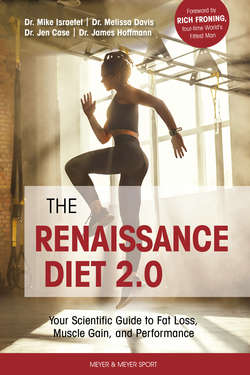Читать книгу The Renaissance Diet 2.0 - Mike Israetel, James Hoffmann - Страница 30
На сайте Литреса книга снята с продажи.
CALORIES AND PERFORMANCE
ОглавлениеCalorie balance is the most important principle for both body composition change and sport performance. Calorie intake affects sport performance by mediating energy availability, facilitating recovery, and influencing body composition (which indirectly affects performance).
At the onset of exercise, the body accesses a variety of fuel sources. Blood glucose from recent food intake is a readily available fuel source but is tightly regulated (in order to maintain glucose supply to the nervous system and keep you functioning). As exertion continues, non-tissue energy sources (carbohydrate stored as glycogen in your muscles) can continue to provide needed fuel at a rate sufficient to maintain athletic performance. Other glycogen stores in your liver act to moderate blood glucose levels as well. When these liver stores become depleted, blood glucose can drop, leading to bouts of hypoglycemia–clearly not great for sport performance. Glycogen stores are built up in the muscles and liver over time as calories are consumed. If an athlete under-eats for intervals of a week or more, their ability to perform at a high level will degrade substantially, even for less energy-intensive activities.
Both blood glucose and glycogen provide energy more quickly and easily than breaking down your body’s tissues. Your fat stores can provide energy for movement as well, but the rate of energy release in this case is much slower and cannot keep up with the energy demands of most sports. To put this in perspective, the breakdown of fat tissue for energy release does not even reach its peak rates until around two hours into an exercise session. Even its peak rates are not as efficient at providing fuel for sport performance as blood glucose and glycogen, making it a much less desirable option. In other words, reducing calories and relying predominantly on fat sources for energy almost always leads to poorer performance.
In addition to providing energy for activity, calories also provide the energy for recovery from training. The process of training for sport is, at least in part, tearing down and rebuilding stronger tissues. Gaining muscle and training for strength both involve induced tissue damage that, under the right conditions, leads to recovery and adaptation to a bigger, stronger state.
Even in cases where an athlete’s current sport progress needs are entirely technical, fatigue and tissue damage will arise just from extensive practice and repetition. Many sports also involve contact, such as American football, rugby, and combat sports, which also results in tissue damage or minor injuries. All this damage must be repaired, and this process requires energy. In addition to providing energy for structural repairs, calorie intake can influence how much glycogen stores are refilled. In a hypocaloric state, most available energy is dedicated to basic bodily function. The body will allocate some energy to support repair and recovery processes, but these resources are limited; the process will be slower, and recovery will be incomplete. (If you are severely hypocaloric, you may not be able to rebuild tissue at all.) In a hypercaloric state, repair and recovery will be optimal thanks to a surplus of energy. (For more information about recovery, see Recovering from Training, available on our website renaissanceperiodization.com as an ebook or audible file.)
Body size is directly affected by calorie intake and influences performance. Calories, therefore, also indirectly affect performance via their influence on body size. Depending on your sport, your body needs to be within some margin of sizes for best performance. For example, if you are the best gymnast at 130 lb. but you only eat enough calories to support a body weight of 90 lb., your diet will be unable to support your best gymnastic performance. You will not have the energy or raw materials to build muscles big enough to perform at your best. If you are a runner, and you eat enough calories to weigh 210 lb. but your best power-to-weight ratio is at 160 lb., you are dragging around an extra 50 lb., inevitably slowing your running times.
